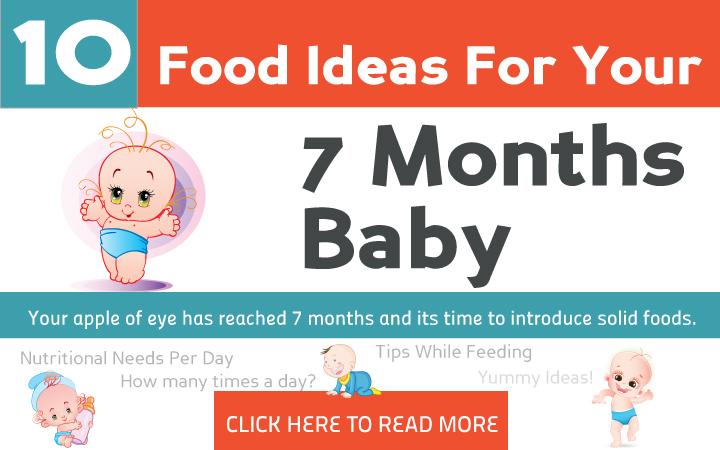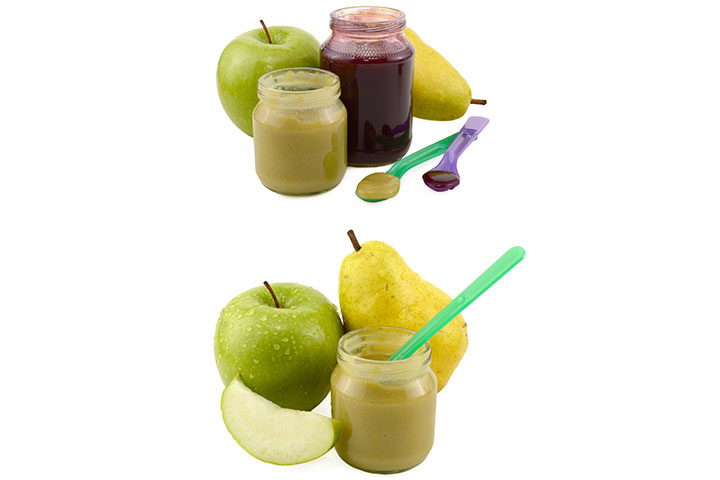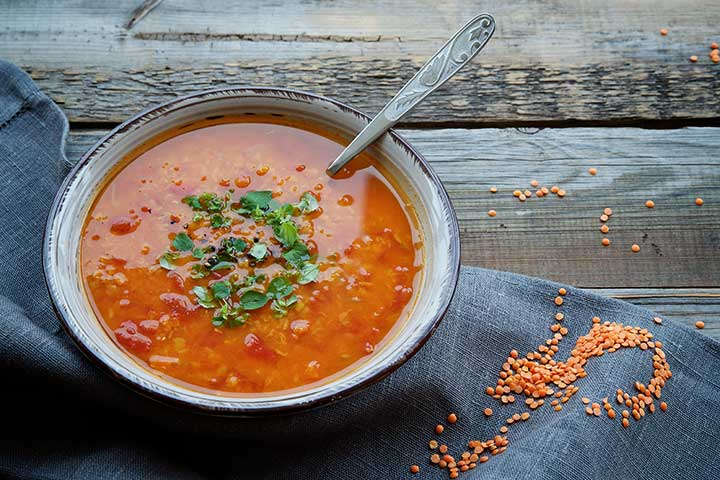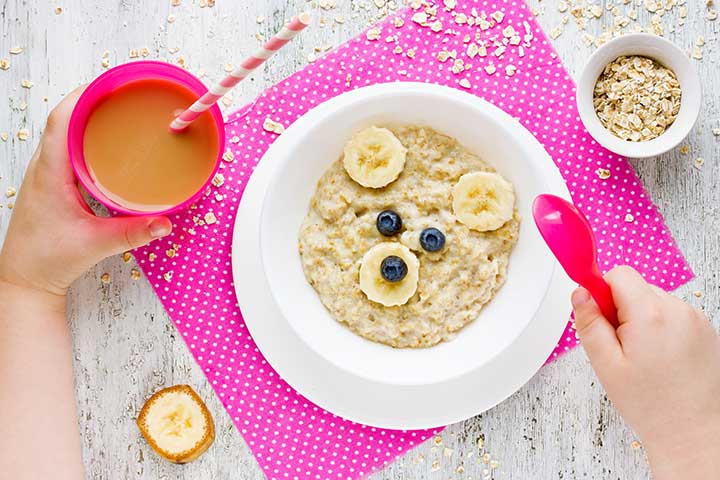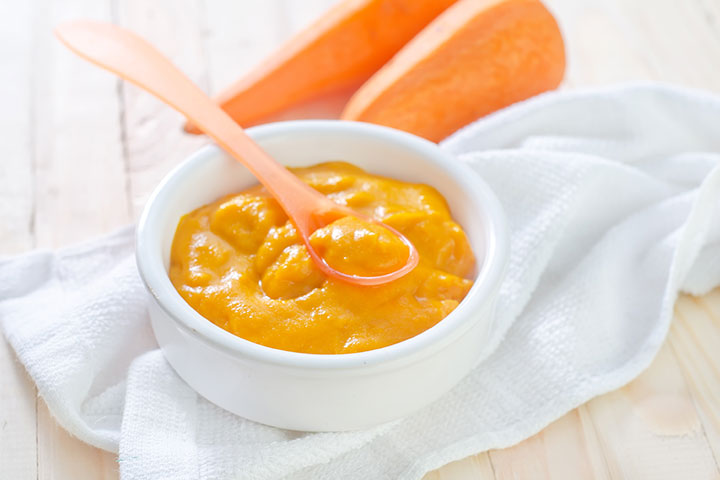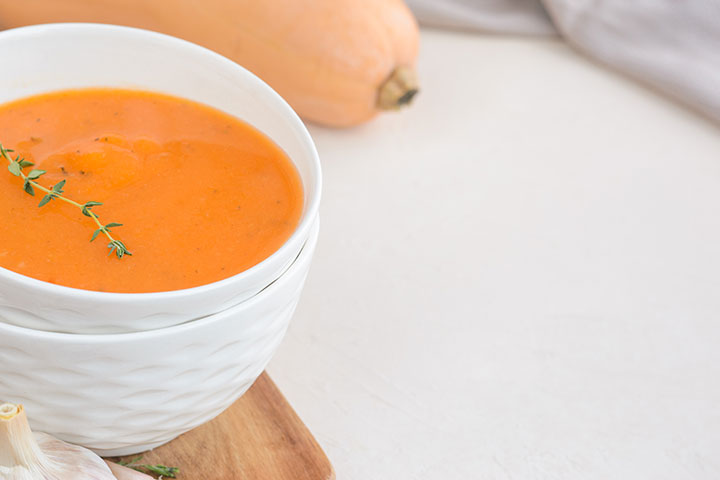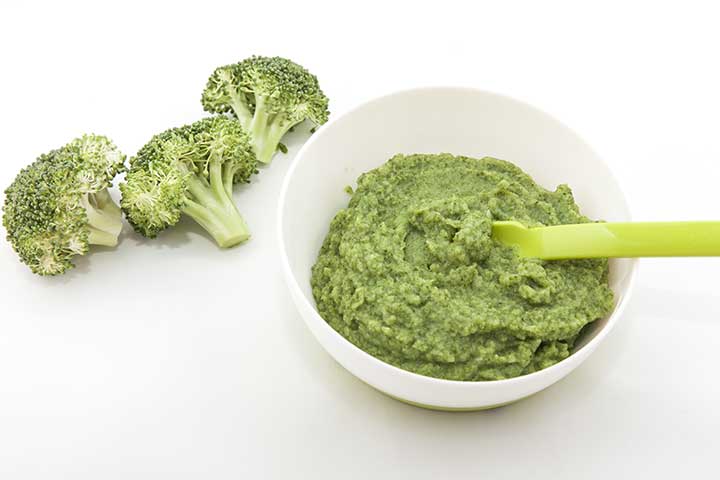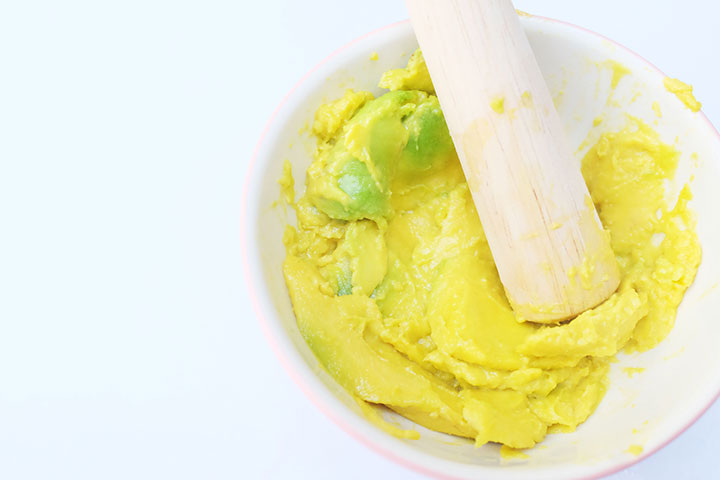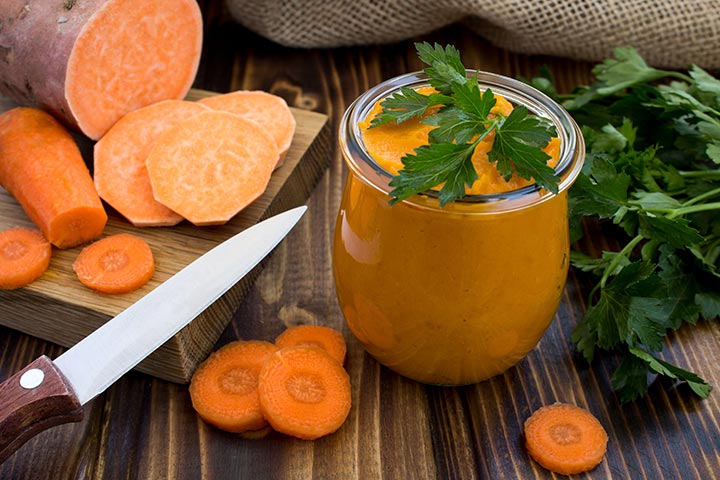If your baby has been transitioning from breastmilk to solid foods, a 7-month-baby food chart can be a helpful guide. During the first six months of life, babies drink breast milk or formula milk to get their complete nutrition. However, after six months, their needs can increase, and it is time to introduce solid foods.
Keeping the transformation slow and introducing foods one by one is essential. Try offering easily digestible, cooked, and mashed food first, then move toward blends. Keep the quantity small and be cautious about choking hazards.
This post provides detailed information on what to feed your 7-month baby and what quantities. It also provides a 7 month baby food chart with some interesting recipes.
How Much Food Should A 7-Month-Baby Eat?
AAP recommends mothers to continue breastfeeding their baby for at least up to 12 months. Offering nutrient-dense foods like pureed meats, iron-fortified cereals, and cooked vegetables can help support your 7-month-old baby’s growth and development. To ensure a balanced diet, it’s important to introduce various foods from different food groups, such as fruits, vegetables, proteins, and grains. At seven months, continue to breastfeed your baby while giving them some solid foods.
According to the Pan American Health Organization (PAHO), continuing breastfeeding for longer can help reduce the risk of overweight/obesity by 13%, helping combat chronic diseases that obesity can cause over time. Hence, it can be said that breast milk may serve as a source of valuable nutrients even if the baby has started consuming solids. However, as the graph depicts, only 24.9% of babies were fed breast milk exclusively when they were six months.
As the data suggests, there is a decline in the number of babies who receive breast milk. CDC indicates that better practices must be implemented to help mothers reach their breastfeeding goals (16).
Percentage of infants receiving any and exclusive breast milk throughout their initial 12 months
Source: Breastfeeding Report Card; CDC
Blanca Garcia, RDN, nutrition specialist at MIDSS, says, “At seven months, an infant’s diet should be mostly breastmilk or formula. If solid foods have already started, they should be complementary to the milk. Only a few small spoons thrice a day are fine, but not whole meals that replace the milk altogether.” According to the US Department of Agriculture (USDA), following portions of food from different food groups may be included in your seven months old baby’s diet (1) (2).
| Food group | Portion size (per day) |
|---|---|
| Breast milk or formula milk | 24 to 32 ounces (oz) |
| Grain products | 1 to 2oz |
| Fruits | 2 to 4oz;
cooked, plain/strained/pureed/mashed |
| Vegetables | 2 to 4oz;
cooked, plain/strained/pureed/mashed |
| Meat and protein-rich foods | 1 to 2oz;
Cooked, plain/strained/pureed/mashed |
Food Options For Your Seven Months Old Baby
Traditionally, parents start with single-grain cereals (3) or single vegetable and fruit (blended, mashed or soft cooked). When your baby is around seven to nine months old, you may include a variety of foods from different groups (2) (4).
Garcia recommends, “Give foods that a seven-month-old can easily chew, such as pieces of banana (mostly mashed), mashed beans and strawberries, age-appropriate cookies, whole-grain pasta, whole-wheat bread, and steamed veggies, such as green beans and peas.”
| Food group | Food items |
|---|---|
| Vegetables | Broccoli, cauliflower, peas, spinach, asparagus, parsnips, peppers, carrots, cabbage, avocado, green beans, kale, and pumpkin |
| Fruits | Banana, apple, mango, blueberries, kiwi, pears, strawberries, papaya, melon, peach, plums, and oranges. |
| Starch-rich foods | Potato, sweet potato, rice, porridge, oatmeal, oats, maize, millet, quinoa, cornmeal, and bread |
| Protein-rich foods | Meat (chicken, lamb, fish without bones), eggs, pulses, lentils, beans, and tofu |
| Dairy | Pasteurized full-fat yogurt without honey, sugar, and artificial sweeteners)
Do not serve milk |
Boil and mash hard fruits like apples before serving it to the baby. You may blend fruits and vegetable purees with formula or breast milk. When choosing meat, you can also consider serving meat broth.
All foods should be soft to prevent the risk of choking. Make sure the baby eats slowly and in small portions.
Click here to view an enlarged version of this infographic.
10 Homemade Baby Food Recipes For Your Seven Months Old
You can try these simple nutrient-rich homemade recipes to introduce your child to different flavors and textures of food (5).
1. Steamed apple and pear puree
You will need:
- ½ apple, peeled and de-seeded
- ½ pear, peeled
How to:
- Cut the apple and pear into wedges or chunks. Put these pieces in a saucepan with water.
- Bring the water to boil and let it simmer for about 7-8 minutes. Allow it cool.
- You can make a puree and also use them as finger food (if your baby is ready to eat finger food). You can use yogurt as a dressing!
2. Eggy omelet fingers
You will need:
- 1 small onion, peeled and chopped
- 1 egg
- ½ teaspoon oil
How to:
- Beat the egg. Cut the onion into small pieces and add it to the egg. Whip them together.
- Put oil in a frying pan. Once the pan is hot, add the mixture and let it cook.
- Let the omelet cool. Cut it into thin slices, and serve it to the baby.
3. Hot lentil soup
You will need:
- Handful of butternut squash peeled
- ¼ onion peeled and chopped
- 30 g red lentils
- ½ tsp oil
- Water
How to:
- De-seed and cut butternut squash into pieces. Finely chop the onions.
- Heat oil in a frying pan. Add all diced vegetables and let them soften.
- Then add water and washed/cleaned lentils to the pan. Bring the water to boil and let it simmer for about 20-25 minutes.
- Check if vegetables and lentils have cooked. Once cooked, let the mixture cool down and blend it before serving.
4. Berry porridge
You will need:
- 2 tablespoon porridge oats
- ¼ banana
- Frozen blueberries (you can use fresh blueberries too)
- 1 tablespoon yogurt
- Water
How to:
- Add oats and water in a saucepan. Let it cook till the mixture thickens and softens.
- Add small pieces or mashed bananas and blueberries as a topping before serving.
5. Tangy chicken fingers
You will need:
- Skinless chicken breast
- ½ lemon juice
How to:
- Take skinless chicken breast and slice it into thin medium-sized pieces.
- Preheat your oven to 200°C (about 400°F).
- Place the chicken slices in a tray and squeeze a few drops of lemon juice on them.
- Bake the chicken for 25 minutes. Once baked, you can mince it or give it as finger food.
6. Veggie hotpot
You will need:
- ½ leek
- ½ carrot, peeled and cut
- 1 potato, peeled and cut
- 1 tablespoon beans, chopped
- 1 small broccoli
- 1 teaspoon oil
- Water
How to:
- Peel and cut carrots and potatoes into small pieces. Cut beans and leeks.
- Take a saucepan with water and add leeks, potato, beans, and carrot. Bring it to boil and let it simmer for 15 to 20 minutes till all vegetables are cooked.
- Once cooked and cooled, blend these vegetables into a puree with pasteurized cream cheese.
- In another pan, cook pieces of broccoli in water for 3-4 minutes. Add these as finger food on top of the puree.
7. Pumpkin and thyme puree
You will need:
- ½ pumpkin peeled and cut
- Thyme leaves
How to:
- Peel, de-seed, and chop pumpkin into small pieces. Place the pieces on a baking tray.
- Preheat the oven to 175°C (about 350°F).
- Place the pumpkin and bake for 30 minutes. Once cooled, add thyme and blend it in a mixer.
8. Broccoli and spinach puree
You will need:
- 1 medium-sized broccoli, chopped
- 5-6 spinach leaves chopped
- Water
How to:
- Bring water to boil in a pan. Add spinach leaves and broccoli florets. Let it simmer for about 10-15 minutes.
- Once cooled, mash it with a fork or blend it before serving it to the baby.
9. Avocado and banana mash
You will need:
- ½ avocado
- 1 banana, peeled
How to:
- Scoop out the avocado and keep it in a pan. Add banana to it and mash.
- You can also add formula or breast milk to the mash and blend it before serving.
10. Root vegetables puree
You will need:
- 1 carrot, peeled and chopped
- 1 sweet potato, peeled and chopped
How to:
- Place the sweet potato and carrot pieces into a saucepan with water. Bring it to boil and let it simmer for around 10-15 minutes or till the vegetables are soft.
- Let the veggies cool down and mash it with a fork or blend before serving.
Seven Months Old Baby Food Chart
You may use this sample food chart for your seven months old baby as a reference (6) (7) (8).
| Meal name | Sample meal |
|---|---|
| Breakfast (morning) | Solid food:
● Iron-fortified infant cereal Liquid: ● Breast milk or formula milk |
| Snack (late morning) | Solid food:
● Pureed or mashed fruits such as banana, kiwi, strawberries, cooked apple, cooked pear with full-fat plain yogurt (unsweetened). Liquid: · Breast milk or formula milk |
| Lunch | Solid food:
● Cooked and finely chopped chicken, ● Cooked and mashed vegetables such as pumpkin, sweet potato, spinach, squash, etc. with cooked and mashed rice. Liquid: ● Breast milk or formula milk |
| Snack (evening) | Solid food:
● Cooked and mashed pear ● Cooked and finely chopped carrots or mashed chickpeas. ● Plain yogurt ● Whole-grain cracker Liquid: ● Breast milk or formula milk |
| Dinner | Solid food:
● Cooked and finely chopped green beans or other cooked vegetables. Liquid: ● Breast milk or formula milk |
Start with one or two tablespoons of food and see if your baby shows signs of being hungry or full. Remember, their bellies are small! You can alternate between solid food and liquids, depending on your baby’s hunger cues.
Try including a variety of colorful foods and textures in the baby’s diet. You can also slowly start introducing finger foods by the end of seven months to develop a habit of self-feeding (6).
Seven Months Old Baby Food Schedule
According to the World Health Organization (WHO), complementary foods (food items apart from breast milk) can be given to babies (six to eight months old) up to two to three times per day (9). In addition, the Centres for Disease Control and Prevention (CDC) recommends that you should give your baby something to drink or eat every two to three hours, that is, about five to six times a day (10).
Tips and Precautions For Feeding A Seven Months Old Baby
These are a few points you should consider when feeding your little one (1) (11).
- Introduce single-ingredient foods at a time. Give the food item for three to five days, during which you do not give any other new food. Observe the baby for any sign of an allergy or sensitivity.
- Baby-led weaning can be a great approach to introduce new foods and textures while also encouraging your baby to self-feed and develop their fine motor skills.
- Gradually increase the variety and quantity of food ingredients; start with a teaspoon and then move to a tablespoon. As your baby grows and their appetite increases, be mindful of portion sizes and avoid overfeeding.
- Offer a diverse range of foods to help support your baby’s developmental milestones, including cognitive and motor development.
- Do not give food items that are hard, sticky, or round and cannot be swallowed by them easily.
- Try giving finger foods if your baby seems ready. Your baby may start grasping items with fingers when ready for finger foods. Ensure you are present when your baby is eating to avoid choking hazards.
- Wash, peel, and remove seeds and pits before giving fruits and vegetables to your baby.
- Use a spoon to feed your baby. Make sure your baby sits in a high chair with a table when feeding.
- When eating out with your baby, prepare your baby’s food from home and carry it with you. Also, choose baby-friendly restaurants with high chairs for the baby and a suitable ambiance.
- Observe and respond to your baby’s hunger cues. Try to develop a predictable routine of all meals and snacks for your baby and limit the time of each meal from 15 to 20 minutes.
- Avoid added salt, sugar, and butter when making baby food at home. In addition, avoid cow’s milk and honey until your baby is at least 12 months old.
- Do not give frozen or overheated food to your baby. The food can either be cold, slightly warm, or at room temperature.
Jennifer House, MSc, a registered dietitian, author, and owner of First Step Nutrition in Calgary, Alberta, says, “Milk choices for a seven-month old include breastmilk or formula only. They can have cow’s milk in foods such as a smoothie or cereal, but not as their main milk source, as it doesn’t contain enough fat and calories.”
How to Know When a Baby Is Ready for Solid Food?
According to the American Academy of Pediatrics (AAP), the following points could indicate that the baby is ready for solid food (3).
- Has good head control.
- Can sit upright in a high chair or a feeding seat (with no or little support).
- Tries to reach out (leans forward) for solid food.
- Opens mouth and seems eager to eat solid food when offered.
- Their fingers are able to grasp items, this is a sign that they are ready for solid/ finger foods.
According to UNICEF, delaying the introduction of solid foods may affect a baby’s healthy weight gain (12). So, encourage your baby to eat solids as soon as they show signs of readiness. A 7-month-baby’s diet chart must include various healthy foods, such as grains, pulses, meat, fish, poultry, fruits, and vegetables. With continued breastfeeding or formula feeding, babies can consume these foods in well-cooked puree or mash form.
They can also consume age-appropriate finger foods if they show signs of readiness. Feed them nutritious foods and drinks every two to three hours to support their proper growth and development. If the baby eats lesser than usual on some days, refrain from force-feeding. Remember, the main source of nourishment even for a seven-month-old is breast milk or formula. They can have solids but in small quantities, as they need time to adjust to weaning food’s taste, texture, and digestibility.
Key Pointers
- 7-month-olds should primarily consume breast milk or formula, with solid foods being complementary to their diet.
- Introduce solid foods gradually, starting with easily digestible, cooked, and mashed options.
- Begin with single-grain cereals, single fruits, and vegetables, then gradually introduce more variety.
- Offer soft, easily chewed foods like bananas, green beans, and whole-grain pasta.
- Foods suitable for 7-month-olds include broccoli, banana, sweet potato, chicken, yogurt, and more.
- All solid foods should be soft to prevent choking.
- Feed the baby upright and in small portions.
Learn how to make a delicious and nutritious chicken and vegetable baby food recipe for your 7-month-old! Follow the easy steps in this video to make a meal your baby will love.

